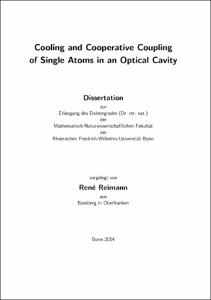Cooling and Cooperative Coupling of Single Atoms in an Optical Cavity

Cooling and Cooperative Coupling of Single Atoms in an Optical Cavity

| dc.contributor.advisor | Meschede, Dieter | |
| dc.contributor.author | Reimann, René | |
| dc.date.accessioned | 2020-04-20T03:48:41Z | |
| dc.date.available | 2020-04-20T03:48:41Z | |
| dc.date.issued | 26.11.2014 | |
| dc.identifier.uri | https://hdl.handle.net/20.500.11811/6202 | |
| dc.description.abstract | In this work the motional state of single cesium atoms strongly coupled to an optical high-finesse cavity is controlled and manipulated by a novel Raman cooling scheme. Furthermore, cavity-modified super- and subradiant Rayleigh scattering of two atoms is observed and explained by collective coupling of the atoms to the cavity mode. We start with the description and comparison of different intra-cavity cooling schemes that allow us to control the motional states of atoms. Cavity cooling is experimentally and theoretically investigated for the two cases of pumping the cavity and driving the atom. In contrast to other cooling schemes, such as EIT- or Raman cooling, our analysis shows that we cannot use cavity cooling for efficient ground-state preparation, but it serves as a precooling scheme for the sideband-cooling methods. Comparing the more efficient sideband cooling techniques EIT and Raman cooling, we find that the experimental efficiency of EIT cooling could not be determined. Therefore we choose a novel, easily implemented Raman cooling technique that features an intrinsic suppression of the carrier transition. This is achieved by trapping the atom at the node of a blue detuned intra-cavity standing wave dipole trap that simultaneously acts as one field for the two-photon Raman coupling. We apply this method to perform carrier-free Raman cooling to the two-dimensional vibrational ground state and to coherently manipulate the atomic motion. The motional state of the atom after Raman cooling is extracted by Raman spectroscopy using a fast and non-destructive atomic state detection scheme, whereby high repetition rates and good signal-to-noise ratios of sideband spectra are achieved. In a last experiment we observe cooperative radiation of exactly two neutral atoms strongly coupled to our cavity. Driving both atoms with a common laser beam, we measure super- and subradiant Rayleigh scattering into the cavity mode depending on the relative distance between the two atoms. Surprisingly, due to cavity backaction onto the atoms, the cavity output power for superradiant scattering by two atoms is almost equal to the single atom case. We explain these effects quantitatively by a classical model as well as by a quantum mechanical one based on Dicke states. Furthermore, information on the relative phases of the light fields at the atom positions are extracted, and the carrier-free Raman cooling scheme is applied to reduce the jump rate between super- and subradiant configurations. | en |
| dc.language.iso | eng | |
| dc.rights | In Copyright | |
| dc.rights.uri | http://rightsstatements.org/vocab/InC/1.0/ | |
| dc.subject | Quantenoptik | |
| dc.subject | Atome in Resonantoren | |
| dc.subject | Atomkühlmethoden | |
| dc.subject | Kooperative Phänomene | |
| dc.subject | Licht-Materie-Wechselwirkung | |
| dc.subject | Wellenoptik | |
| dc.subject | quantum optics | |
| dc.subject | atoms in cavities | |
| dc.subject | atom cooling methods | |
| dc.subject | cooperative phenomena | |
| dc.subject | light-matter interaction | |
| dc.subject | wave optics | |
| dc.subject.ddc | 530 Physik | |
| dc.title | Cooling and Cooperative Coupling of Single Atoms in an Optical Cavity | |
| dc.type | Dissertation oder Habilitation | |
| dc.publisher.name | Universitäts- und Landesbibliothek Bonn | |
| dc.publisher.location | Bonn | |
| dc.rights.accessRights | openAccess | |
| dc.identifier.urn | https://nbn-resolving.org/urn:nbn:de:hbz:5n-38324 | |
| ulbbn.pubtype | Erstveröffentlichung | |
| ulbbnediss.affiliation.name | Rheinische Friedrich-Wilhelms-Universität Bonn | |
| ulbbnediss.affiliation.location | Bonn | |
| ulbbnediss.thesis.level | Dissertation | |
| ulbbnediss.dissID | 3832 | |
| ulbbnediss.date.accepted | 05.11.2014 | |
| ulbbnediss.institute | Mathematisch-Naturwissenschaftliche Fakultät : Fachgruppe Physik/Astronomie / Institut für angewandte Physik (IAP) | |
| ulbbnediss.fakultaet | Mathematisch-Naturwissenschaftliche Fakultät | |
| dc.contributor.coReferee | Schlemmer, Stephan |
Dateien zu dieser Ressource
Das Dokument erscheint in:
-
E-Dissertationen (4387)




